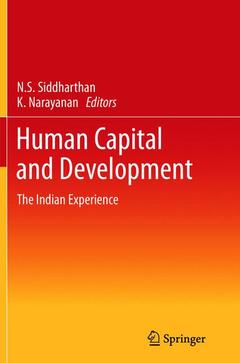Description
Human Capital and Development (2nd Ed., 2nd ed. 2013)
The Indian Experience
Coordinators: Siddharthan Natteri, Narayanan Krishnan
Language: English
Subjects for Human Capital and Development:
Keywords
Development; Education; Energy; Human Capital; Skill Formation
Human Capital and Development
Publication date: 01-2015
Support: Print on demand
Publication date: 01-2015
Support: Print on demand
Human Capital and Development (2nd Ed.)
Publication date: 12-2012
158 p. · 15.5x23.5 cm · Hardback
Publication date: 12-2012
158 p. · 15.5x23.5 cm · Hardback
Description
/li>Contents
/li>Biography
/li>Comment
/li>
The papers included in this volume cover several aspects of human capital. It starts with the role of human capital in influencing productivity, employment and growth of employment. The chapters show that Indian States that have been neglecting schooling and health facilities have become victims in terms of low productivity and lower rates of employment. Consequently, employment cannot be increased without spending on education and health. Furthermore, the unorganised sector in India cannot provide gainful employment as productivity in this sector is low and is also declining. Skill intensity influences mainly productivity in the organised sector. As a result, states that have been neglecting human capital would lose on both counts. The chapters also reveal that human capital could be substituted for energy use and help in reducing energy consumption and pollution. India is also one of the important exporters of human capital and the non resident Indians send remittances back to India. The volume indicates that remittances play a significant role in poverty reduction and increase in per capita consumption levels. In addition remittances, unlike foreign direct investments and portfolio investments, are less erratic and are not influenced by slowdown in the world economy. Poverty could also be directly attacked through the use of anti poverty programmes like NREGA. This volume provides an analytical framework and a theoretical model to analyse the impact of these programmes to examine their influence on labour demand, income, prices and productivity. The volume also emphasises the crucial role of the government in directly running education institutions. As seen from the volume government run engineering institutions are technically more efficient than the private run ones.
Human Capital and Development: Introduction.- Human Capital, Labour Productivity and Employment.- Impact of Human Capital on Manufacturing Productivity Growth in India.- Informality, Vulnerability and Development.- Labour and Energy Intensity: A Study of Pulp & Paper Industries in India.- Impact of Remittances on Poverty in India: Empirical Evidence.- Understanding NREGA: A Simple Theory and Some Facts.- Measuring Efficiency of Technical Educational Institutions In Kerala Using Data Envelopment Analysis.
N. S. Siddharthan retired as Professor and Head, V.K.R.V. Rao Centre for Studies in Globalisation, Institute of Economic Growth, University of Delhi, and is currently Honorary Professor at the Madras School of Economics, Chennai and Honorary Director, Forum for Global Knowledge Sharing. His current research interests include technology and globalisation, international economics, multinational corporations, and industrial organisation. His latest published works include Changing Policy Regimes and Corporate Performance (co-authored with B.L. Pandit, OUP, 2009) and High-tech Industries, Employment and Global Competitiveness (co-edited with S.R. Hashim, Routledge, 2008) among others. K. Narayanan is Institute Chair Professor & Head, Department of Humanities and Social Sciences, Indian Institute of Technology Bombay. His research areas are development economics, industrial economics, international business, industry–environment linkages, socio-economic impacts of climate change. His recent publications include research papers in Technovation, Oxford Development Studies, International Journal of Energy Economics and Policy, and Indian and Chinese Enterprises: Global Trade, Technology and Investment Regimes (co-edited with N. S. Siddharthan, Routledge, 2010).
Covers various dimensions of the relationship between human capital and development
Analyses the role of technology as well as government policy measures in human capital formation
Covers education and energy, among others, in fostering development in an emerging economy?
© 2024 LAVOISIER S.A.S.




